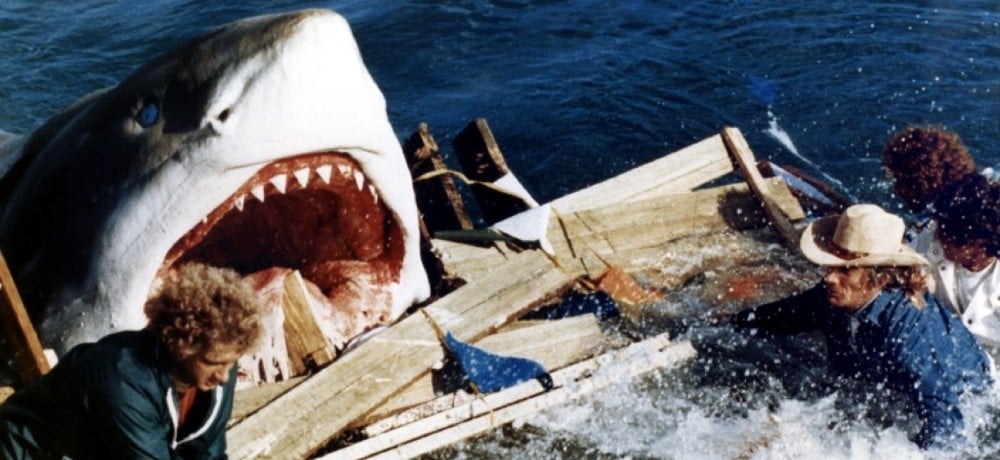


While Universal was working on the second sequel of Jaws (1975), the franchise famously created by Steven Spielberg then passed on to Jeannot Szwarc in 1978, poliziesco specialist Enzo G. Castellari shot L’ultimo squalo (The Last Shark a.k.a. Great White, 1981) between the U.S. and Malta, creating quite a few headaches within white-collar Hollywood. The film did overwhelmingly and surprisingly well, grossing $18 million in the first month of programming, a fact that greatly annoyed Universal, which filed a lawsuit for plagiarism. To be precise, this was the studio’s second attempt at blocking the film. Universal attempted to stop distribution by Film Ventures before its U.S. premiere on March 5th, 1982, but the request was denied in the U.S. district courts. If, on the one hand, the filiation of Castellari's film from the original one is quite evident (with similar characters and narrative solutions), on the other it is also clear that Universal activated its legal team first and foremost to put a stop to the havoc of consensus, something potentially damaging for the upcoming Jaws 3D. However, whether the reasons were legitimate or simply stemmed from the Hollywood studio not wanting Italians saturating the market with sharks, the fact remains that the second time around, federal judge David V. Kenyon ruled the film too similar to Jaws, and The Last Shark was subsequently pulled from theaters, interrupting its box office fortune.
In Port Harbor, William Wells (Joshua Sinclair) is running for the office of Governor; among the initiatives promoted by the ambitious politician is a windsurfing competition. A few days before the event, however, a young athlete disappears just as he is practicing in the water. Subsequently, a mangled board is found, bearing the teeth marks of an abnormally large shark. One of the surfer's companions alerts her father, Peter Benton (James Franciscus), a shark expert and writer, who, in turn—paired with a very experienced local shark hunter, Ron Hamer (Vic Morrow)—alerts Wells, telling him to cancel the race. Another body is found offshore (or rather, pieces of a body); nevertheless, Wells intends to allow the competition to proceed as planned, while delimiting the area with underwater barriers and anti-shark nets and observing strict safety regulations. During the race, the shark is sighted, but a massacre is avoided. Benton and Hamer decide to hunt for it and, unbeknownst to them, the boys from South Bay also recklessly embark on the same undertaking. At first it is Benton and Hamer who almost lose their skin (the shark imprisons them in an underground cave), then it's up to the boys, and, unfortunately, Benton's daughter is bitten in the leg after falling into the water. The community is shocked and the shark hunt starts again, reaching the film’s obvious climax.
Despite having to deal with a blatantly derivative, but ambitious script, the Roman director manages to establish a more than dignified, and, in some respects, surprising production. The making was riddled with drawbacks, such as the animatronic creature shutting down halfway through production, forcing Castellari to work exclusively with the robot’s head. The solution is also found in the extensive use of archival footage (unfortunately, despite solid editing choices, the photographic and film stock differences are too easily noticeable) and in the drastic reduction of the creature’s presence on screen. Spielberg himself faced similar problems, both technical and meteorological, but it must be said that the production of the two films had decidedly different frameworks. The use of underwater models is easily noticed, and often there is also the feeling that the dimensions of the enormous shark are not kept consistent. Castellari deserves more than a nod for having achieved as much as he did with what was given to him, but the comparison with Spielberg creates some embarrassment, and Universal's fears and legal suit probably gave the film more notoriety than it would have ever achieved on its own. Needless to say, Spielberg's masterpiece—because that is what it is—does not fear any competition, while recognizing all the qualities and inventiveness of Castellari’s film, not to mention its tenacity in having challenged the Americans on their own ground (indeed, in their own waters).
The music is by the De Angelis brothers, who focus on less minimal music than John Williams' original score and are more heavily influenced by the sounds of the new decade. Castellari was satisfied with the result, and he rejoiced at having made it with much less money than Spielberg had at his disposal (and, according to him, with a lot more cunning). The behavior of the big fish always remains questionable: it’s extremely aggressive, cruelly logical, and capable of elaborate planning, things that will naturally displease any marine biologist horrified to be faced with a shark that knowingly stalks a cave in an attempt to bury two divers alive, or who throws itself out of the water like a 12-meter salmon to grab a helicopter and drag it into the depths of the ocean, but, if anything, the outrageous ideas are part of the film’s charm.
FUN FACT: The first version of the script, penned by Ugo Tucci, was offered to director Ruggero Deodato, as he himself recalls: “It was 1979 and I think it was producer Amati that came to me with this project. I was extremely skeptical and the story did not convince me, but I stalled until Cannibal Holocaust arrived shortly after, and I then realized what I had to do.”
---------
Visit our online hub to catch up on all of our Class of 1981 retrospectives!